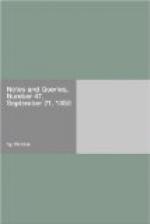Pilgrims’ Road (Vol. ii., p. 237.).—Your correspondent S.H., in noticing the old track “skirting the base of the chalk hills,” and known by the name of the “Pilgrims’ Road,” has omitted to state that its commencement is at Oxford,—a fact of importance, inasmuch as that the Archbishops of Canterbury had there a handsome palace (the ruins of which still exist), which is said to have been the favourite residence of Thomas a Becket. The tradition in the county thereupon is, that his memory was held in such sanctity in that neighbourhood as to cause a vast influx of pilgrims annually from thence to his shrine at Canterbury; and the line of road taken by them can still be traced, though only portions of it are now used as a highway. The direction, however, in which it runs makes it clear (as S.H., no doubt, is aware) that it cannot be Chaucer’s road.
While on the subject of old roads, I may add that a tradition here exists that the direct road between London and Tunbridge did not pass through Sevenoaks; and a narrow lane which crosses the Pilgrims’ road near Everham is pointed out as the former highway, and by which Evelyn must have been journeying (passing close, indeed, to the seat of his present descendant at St. Clere) when he met with that amusing robber-adventure at Procession Oak.
M(2).
Pilgrims’ Road to Canterbury.—In the Athenaeum of Nov. 2nd, 1844, there is a notice of Remarks upon Wayside Chapels; with Observations on the Architecture and present State of the Chantry on Wakefield Bridge: By John Chessell and Charles Buckler—in which the reviewer says—
“In our pedestrianism
we have traced the now desolate ruins of
several of these chapels along
the old pilgrims’ road to
Canterbury.”
If this writer would give us the results of his pedestrianism, it would be acceptable to all the lovers of Chaucer. I do not know whether PHILO-CHAUCER will find anything to his purpose in the pamphlet reviewed.
E.S. JACKSON.
Combs buried with the Dead.—In Vol. ii., p. 230., the excellent vicar of Morwenstow asks the reason why combs are found in the graves of St. Cuthbert and others, monks, in the cathedral church of Durham. I imagine that they were the combs used at the first tonsure of the novices, to them a most interesting memorial of that solemn rite through life, and from touching affection to the brotherhood among whom they had dwelt, buried with them at their death.
M.W.
The Comb, concerning “the origin and intent” of which MR. HAWKER (Vol. ii., p. 230.) seeks information, was for ritual use; and its purposes are fully described in Dr. Rock’s Church of our Fathers, t. ii. p. 122., &c.
LITURGICUS.
Aerostation.—C.B.M. will find in the Athenaeum for August 10th, 1850, a notice of a book on this subject.
E.S. JACKSON.




